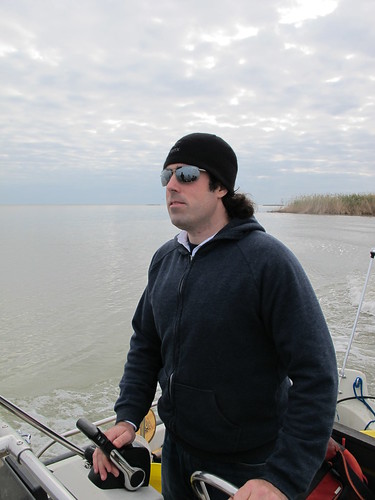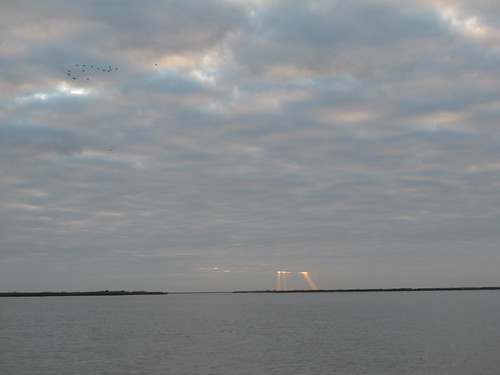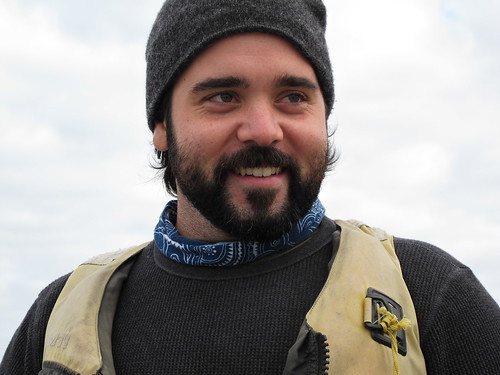Hunting for Oil in the Muddy Waters of the Gulf Shore
While Americans frantically dash through crowded strip malls, Paul and Michael Orr jump into their 17-foot Boston Whaler ready to hunt for a different kind of merchandise—the kind that grows in the Gulf of Mexico. They are searching for samples of seafood and sediment located in the oil damaged bayous of Louisiana. And what they have found so far may lead to important revelations about potential contamination along the entire Gulf coast.
The Orr brothers work for the Louisiana Environmental Action Network, a group that has worked closely to monitor the environmental impacts of the worst oil disaster in US history. The Orrs are rugged environmentalists who grew up boating and fishing with their father throughout Pelican state. Since August, they have been working with McArthur “genius grant” recipient Wilma Subra to collect samples from the inlets and coastline, looking for oil and chemical contamination in oysters, shrimp, crab and sediments. They are looking in areas they believe the government has not. And they have found plenty.
Just last week LEAN posted the latest results of their tests, finding high levels of petroleum hydrocarbons in crab, shrimp, oysters and redfish.

Paul (top) and Michael Orr, Pass a Loutre, LA
Photos by Rocky Kistner/NRDC
Paul and Michael know they are fighting against a rip tide of government reports saying the Louisiana seafood is safe to eat. But like many fishermen in the bayou, they're worried about what they can't see, smell or taste.
“We’re just out here trying to figure out what’s in the environment," Paul Orr says. “We’ve been consistently finding levels of contamination the government isn’t finding. And we’re using the best certified labs and sampling techniques.”
The brothers guide their boat out of Venice harbor, once teeming with oil cleanup workers and Coast Guard personnel. Now most of them are gone, but the Orrs say the oil is not. They have seen it on nearly every trip to the remote coastlines of the Louisiana bayou. It’s no longer floating on the water's surface in thick crusty crude-filled carpets, but it’s buried deep in the sand and mud along the coastal shores. No one knows how much still remains underwater, hidden from sight and out of mind. But the oily residue is probably leaching into seafood in some places. And that’s what the Orr's intend to find out.
As the small boat heads down the massive Mississippi River channel south of Venice, we come to the Head of Passes, where the river splits into multiple channels that funnel billions of gallons of river water and nutrients into the Gulf. The Orr’s take the left channel, Pass A Loutre, which is a remote channel not used by commercial river traffic. Beautiful rows of Rosetta canes stretch out for miles as far as the eye can see. Snowy egrets, brown pelicans and seagulls soar and dive for fish in the river.
Suddenly, the dream-like scenery comes to a lurching stop. A thick brown cloud rises from the river bottom. It’s not oil, but silty Mississippi River mud in deceptively shallow sandbars under the opaque river water. Michael and I jump out of the boat and begin to push. The water is cold, a lot colder than just a few months ago. Winter weather up north has pushed frigid water south down the Mississippi, pushing Louisiana shrimp and sea life further out into the warm waters of the Gulf.

Finally we push the boat into a slightly deeper channel and set off down the river. We end up repeating this exercise several times. It’s nearly impossible to know where to avoid sandbars down here. They shift and move constantly with the tides and wind.
After an hour we finally reach the mouth of the river pass, where the steel grey vastness of the gulf stretches out into the void. An old dark lighthouse sits in the middle of the channel. It once was on land, but now it's completely encircled by water; a telltale sign of the rapid coastal destruction eroding the marshlands here.
Michael grabs a crab trap stuffed with chicken necks and flings it into the river. He's out to catch some crabs and bring them back to test for evidence of oil contamination. From a vantage point on the surface, it’s hard to imagine an oil polluted environment. But what lurks below the surface may be another story.
The brothers push off from the shoreline and head south into the Gulf and down the coastline. The wind is blowing steadily, but it’s a south wind that's warmer than the breeze upriver. About 10 miles down the coast we pull in close to shore and Paul and I wade onto the beach. He’s off to collect soil sediments in an area they tested back in August. They want to compare samples to see if things have gotten better—or worse—since the well was capped last summer.
At first the coast appears normal. No evidence of tar balls, at least not today. It's been scrubbed by cleanup crews. But further back in the marsh grass it’s a different story. Lines of brown streaks stain the mud and sand, and a smell of oil wafts up from the reeds. I push my foot into the soft mud and sandy soil and an oily sheen of waters bubbles up, spreading like gasoline poured on a puddle.



Photos by Rocky Kistner/NRDC
This is dramatic evidence the oil is still here. It's stuck here and saturated the ground like a brown poisonous tide. What it is doing to the environment and the wildlife along these shores is hard to know. Only time will tell.
Paul digs up samples of oily mud and soil and stuffs them into sterilized jars. The smell test is pretty clear. No doubt this is oil, no doubt it’s soaked into the muddy sediment. “This is pretty discouraging,” Paul says. “It wasn’t that much different when we sampled in August back here.”
Slowly we wade back to the bobbing boat offshore. We fire up the engine and begin the two-hour journey home under a darkening sky. As we reach the river pass, rows of ducks can be seen bobbing in the water and flying across the horizon. It’s part of the great fall and winter bird migration, a aerial highway of millions of ducks, geese, and migratory birds that stop to use these marshlands as a feeding ground for the winter.

Photo by Rocky Kistner/NRDC
But will the oily residue impact these birds? Will it contaminate the crabs, oysters and animals that thrive in the marshy environment? No one can say. We can only demand tests that verify and document what is happening to this unique environment, a treasured resource severly damaged by massive levies, oil and gas pipelines and now 200 million gallons of oil spewed into the ocean.
For Paul and Michael Orr, this is a holiday season to celebrate with the rest of the country. But it’s not a time to relax. There’s too much at stake. The BP oil disaster has caused economic hardship for millions of people along the gulf coast, and its environmental toll won’t be known for years.
People like the Orrs want to make certain that we learn from this disaster and quickly shift to a clean energy economy so we won’t have to relive this nightmare again. And they have witnessed the true cost of our oil-addicted economy. It's buried right here in the sand and mud at the mouth of the Mississippi River.

